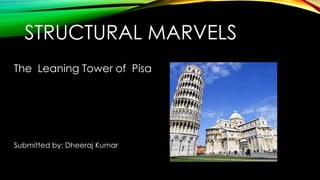
Leaning Tower of Pisa
- 1. STRUCTURAL MARVELS The Leaning Tower of Pisa Submitted by: Dheeraj Kumar
- 2. INTRODUCTION • One of the “SEVEN wonders of the World.” • Located in PISA, Italy at the 'Piazza del Duomo' square. • One of the 3 oldest monuments in the Pisa’s Cathedral Square • Bell tower for the Cathedral of Pisa. • Renowned all over the world for its peculiar inclination. • The tilt began during construction and continued further increasing gradually. • The tilt was stabilized in the 20th -21st century.
- 3. HISTORY OF THE BUILDING • The building took almost 200 years to complete with two great interruptions. Starting in 1173 and ending in 1370. • By 1178, the Third floor was complete. It was observed at this stage that the tower was leaning on the north side, and construction was on hold because of neighboring wars. • The tower kept shifting to one side over the years, around 1.2 millimeters from the vertical every year. • In 1990 the tilt was about 6 arc seconds per year which is equivalent to a horizontal movement of about 1.5mm per year
- 5. CHARACTERISTICS OF THE TOWER • Weight = 14,700 metric tones • Ring shaped diameter = 19.6 m • Thickness of wall =4.1 m, and 2.7 m for all other levels. • Inclination = 5 ½ degree’s to the south. • 15 half columns at the base. • 180 columns for base. • 12 columns for belfry.
- 6. History of the Construction.
- 7. CONSTRUCTION PRINCIPLES/METHODS • The tower was built as a hollow masonry cylinder surrounded by 6 colonnades with columns and vaults rising from base cylinder. • According to a detailed computer analysis, while the average foundation pressure is 500kpa, the pressure at south edge was about 1000kpa whereas the pressure at the north edge was nearly zero. • The ground underlying Pisa tower consisted of 3 formations • Horizon A: 10m thick soft estuarine deposits of sandy and clayey silts. • Horizon B: 40m depth of soft sensitive normally consolidated soil. • Horizon C: dense marine sand extending up to a depth of 60m
- 8. Underlying Soil profile. Cross-section in the plane of maximum inclination, situation in year 1993.
- 9. CAUSES OF LEANING OF THE TOWER • Lack/limited of Engineering knowledge in the medieval-era. • Creep in the underlying marine clay. • The unstable mixture of soil – caused the tower to sink to the south side. • Soil at south side compressed faster than the north side – weight of the tower was the main factor of tilt. • Tilting was also due to the fluctuations of the water levels. • This caused the tower to keep shifting, as well as rotate…later discovered by scientists that the tower’s position shifted in relation to the ground water level.
- 10. Ground water level fluctuation in horizon A Motion of Tower foundation during steady creep
- 11. COUNTER MEASURES(TEMPORARY) • In 1992, plastic coated steel wires were wrapped around the south side of the second floor to prevent a type of failure called “Buckling”(occurs when heavily stressed walls burst outwards). • By the 2nd half of 1993, 600T of lead weights were attached to the north side of the foundation by attaching a post-tensioned removable concrete ring- cast around the base. • This caused in reduction of inclination of about 1 minute and reduced the overturning moment by 10% • In September 1995 the load was increased up to 900T in order to control accelerating southwards movement but was unsuccessful.
- 12. Lead counterweight on the North Side.
- 13. COUNTER MEASURES(PERMANENT) • It was found that small inclination of ½ degree was not enough to stabilize the foundation. • Different methods such as: • Drainage beneath north side using well • Consolidation of soil using e-osmosis. • Loading of north side using ground anchors None worked Thus Soil Extraction/Soil Excavation technique was applied.
- 14. SOIL EXCAVATION/EXTRACTION TECHNIQUE • Contractors removed soil from the north side with drilling equipment. • The tower started to sink on the north side, therefore reducing some of the stress that was building up on the south side. • Suspension cables were loosely fitted to the tower so it could pull back the tower incase it started leaning.
- 15. CONTD… • The soil excavation technique was found to be extremely effective. • The tower was not straightened and has a stable inclination of 3.99 degrees. • The stability of the tower has been predicted to last for 300 years. • The tower has not yet collapsed as the structure is made of lime-stone and is capable of handling more stress than any other building stone.
- 16. A view looking up
- 17. Stair Case of 6th floor Stair case of 7th floor Stairs at the 8th floor
- 18. Plaque in the memory of Galileo Galilei's experiments.
- 19. BELLS OF THE TOWER
- 20. CONCLUSION The Leaning Tower of Pisa, one of the seven wonders of the world faced instability and started inclining due to bad engineering and weak soil profile. In addition to that the city of Italy has a high ground water level which further worsened the condition. Due to instability conditions the building was shut off in 1990 and after taking necessary countermeasures the building reopened for tourists in 2001. In 2008, 70 tons of weight were removed as the tower had stopped moving fo the first time in history. The building Is predicted to remain stable for 300 years to come.
- 21. THANK YOU
